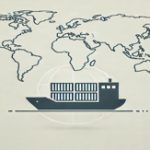Introduction
E-commerce has changed how food is bought and sold across the globe. It has transformed traditional export models, allowing businesses to reach new markets without setting foot outside their home country. With digital platforms, exporters can showcase their products, connect with buyers, and complete transactions seamlessly. For food exporters, this means fewer middlemen, greater market access, and the ability to scale operations efficiently.
But how exactly does e-commerce fuel food exports? What challenges come with it? And what are the best strategies to maximize its potential? Let’s dive into the details.
Breaking Barriers: How E-commerce Expands Food Exports
1. Access to Global Markets
E-commerce removes geographical barriers. A small cassava flour producer in Nigeria can sell to buyers in Europe, Asia, or North America without needing a local distributor. Marketplaces like Alibaba, Amazon, and specialized food export platforms provide direct access to buyers who are actively looking for quality food products.
With a well-optimized online presence, food exporters can attract international customers who might have otherwise never discovered their products. The right e-commerce strategy ensures visibility in competitive markets, making even small players stand out.
2. Lower Costs and Higher Profit Margins
Traditional food export involves layers of intermediaries—wholesalers, distributors, and retailers—all of whom take a cut. E-commerce allows exporters to bypass many of these players, selling directly to consumers or businesses.
Lower overhead costs mean better pricing for customers while increasing profit margins for exporters. Even better, with the right digital marketing approach, businesses can control their branding, positioning, and pricing strategies without interference from middlemen.
3. 24/7 Sales Without Borders
Unlike physical trade, e-commerce never sleeps. Online platforms operate 24/7, allowing food exports to happen around the clock. A customer in Canada can place an order for Nigerian dried ginger at midnight, and the transaction is processed automatically.
This always-on approach increases sales opportunities and ensures that businesses don’t miss out on demand from different time zones. Automation in logistics, payment processing, and order fulfillment further enhances the efficiency of cross-border food trade.
4. Meeting International Compliance and Certification Needs
One major hurdle in food exports is compliance with international standards. Buyers in Europe and North America require strict adherence to food safety regulations. E-commerce platforms help bridge this gap by offering transparent product information, certifications, and traceability solutions.
Some platforms even provide built-in compliance checks, making it easier for exporters to meet necessary requirements. This simplifies the process for both sellers and buyers, increasing trust and boosting trade.
Challenges in E-commerce for Food Exports
1. Logistics and Shipping Complexities
Selling food internationally sounds great—until you realize the challenges of shipping perishable goods. Different countries have different import rules, and delays at customs can lead to spoilage.
For non-perishables like dried hibiscus flowers or sesame seeds, logistics is easier. But for fresh and frozen food, exporters must invest in cold chain logistics. Smart partnerships with reliable freight forwarders and fulfillment centers are crucial.
2. Payment and Currency Issues
Selling globally means dealing with multiple currencies and payment methods. Not every buyer is comfortable with wire transfers, and not all exporters trust online payments.
Thankfully, platforms like Payoneer, Stripe, and escrow services help bridge this trust gap. Exporters must also consider foreign exchange fluctuations, ensuring they price their products to accommodate currency shifts.
3. Trust and Brand Recognition
Would you buy food online from a company you’ve never heard of? Probably not. That’s the challenge many food exporters face. While e-commerce opens doors, buyers still need assurance of quality, reliability, and credibility.
Building trust requires strong branding, customer reviews, and a clear return policy. Transparency in sourcing, production, and handling processes also reassures buyers.
Winning Strategies for Food Exporters in E-commerce
1. Optimize for Search and Visibility
If no one can find your product, they won’t buy it. SEO (Search Engine Optimization) is critical for e-commerce success. Using keywords like “organic Nigerian sesame seeds” or “export-quality cassava flour” helps attract the right buyers.
Product descriptions must be detailed, highlighting certifications, origin, and benefits. High-quality images and engaging videos further enhance product appeal.
2. Leverage Marketplaces and B2B Platforms
Selling from a standalone website is good, but leveraging large e-commerce platforms is better. Amazon, Alibaba, and global B2B food trade platforms bring in millions of buyers. Listing products on these platforms increases exposure and sales potential.
Additionally, specialized agro-food export platforms cater specifically to bulk buyers, making them an excellent channel for high-volume sales.
3. Build a Strong Social Media Presence
Social media isn’t just for engagement—it’s a powerful sales tool. Platforms like Instagram, LinkedIn, and Facebook allow food exporters to showcase their products, interact with potential buyers, and even close deals directly.
LinkedIn works well for B2B food exports, while Instagram and TikTok help attract individual buyers with eye-catching visuals and storytelling. The more engaging and transparent the brand, the more trust it builds.
4. Ensure Reliable Payment and Delivery Options
A customer’s greatest fear when ordering food online is fraud or lost shipments. Offering secure payment methods and reliable shipping solutions reduces this concern.
Exporters should work with reputable payment providers and logistics partners that guarantee safe and timely delivery. Options like cash on delivery (for select regions), buyer protection programs, and shipment tracking build confidence among international customers.
5. Invest in Customer Service and Support
E-commerce isn’t just about selling; it’s about relationships. Exporters must provide excellent customer support, answering inquiries promptly and resolving issues quickly.
Live chat, email support, and dedicated account managers can make a big difference in closing deals and retaining long-term clients. Happy customers leave positive reviews, which, in turn, attract more buyers.
The Future of Food Exports Through E-commerce
E-commerce will continue to shape the future of food exports. Technologies like blockchain for traceability, AI-driven customer insights, and drone deliveries are already making waves. As digital trade grows, food exporters who embrace e-commerce early will enjoy a competitive advantage.
The key to success lies in adapting to market trends, staying compliant, and delivering quality products with reliable service. Those who do it right won’t just sell food—they’ll build lasting international brands.
Final Thoughts
E-commerce has transformed food exports from a complex, paperwork-heavy process into a seamless, global trade opportunity. It lowers costs, expands market reach, and increases sales efficiency. But success doesn’t come automatically—exporters must optimize visibility, ensure reliable logistics, and build trust with buyers.
For those who get it right, the rewards are immense. Whether selling sesame seeds to Europe, cassava flour to Asia, or hibiscus flowers to the U.S., e-commerce is the key to unlocking massive opportunities in global food trade.
You can contact us on WhatsApp to discuss this topic further.




